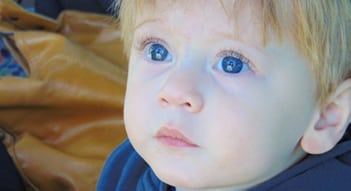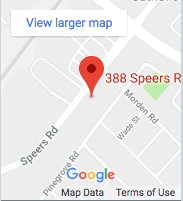
A baby’s vision develops in stages. In the first week of life, a newborn’s vision is blurry and lacks detail. Newborns see only in shades of gray and it takes several months for vision to fully develop.
During Pregnancy
A child’s visual development begins before they are even born. How a mother cares for her own body during pregnancy is very important for the development of the baby’s mind and body, including the eyes and the vision centers in the brain.
Smoking, alcohol and drugs consumed during pregnancy are toxins that can cause serious vision problems, along with multiple other problems for the baby. It’s also important that a pregnant woman follows the instructions of her doctor regarding proper nutrition and an adequate amount of rest.
At Birth
At birth, nerve cells in the retina and brain that control vision are not yet fully developed, so a baby sees only in black and white. Also, newborn eyes don’t have the ability to focus on near objects. If a newborn doesn’t seem to be focusing on your face or other objects right away, it’s not a cause for concern. It simply takes time, and, despite these limitations, studies show that infants prefer looking at an image of their mother’s face over anyone else’s, within a few days after birth.
The First Month
Within the first few weeks of life, a baby’s colour vision develops and they begin to see the world in full colour. However, if your baby’s eyes occasionally look unfocused or misaligned, it’s nothing to worry about, because visual acuity and eye teaming takes a bit longer.
An infant’s eyes are not as sensitive to visible light as adult eyes are, but he still needs protection from the sun’s harmful UV rays. Always keep your baby’s eyes shaded when he’s outdoors.
Months Two and Three
During months 2 and 3, a baby’s vision improves to the point where her eyes are beginning to move better as a team. At this stage, she can follow moving objects and is starting to reach for the things she sees.
By now, an infant is learning how to shift her eyes from one object to another without having to move her head.
Months Four to Six
Significant advances take place in the vision centers of the brain by 6 months of age. These changes allow your baby to see more distinctly and move his eyes faster and more accurately to follow moving objects. Your baby should have his first eye exam between the ages of six and nine months of age.
Visual perception improves rapidly, from about 20/400 at birth to about 20/25 at six months of age. Your child’s color vision should be nearly fully developed at age six months as well, allowing him to easily see all colours.
Better hand-eye coordination has also developed by this point and babies are quickly able to locate and pick up objects, such as a bottle, and direct it to his mouth.
Months Seven to Twelve
At this age, your child is now mobile, crawling about and covering more distance than you might have expected. She is also better at judging distances and is more skilled at locating, grasping and throwing objects.
Your child will have developed a better awareness of her body and is learning how to coordinate her vision with her body movements. You will have to watch her closely to keep her from harm as she explores her surroundings. Cabinets that contain cleaning supplies should be kept locked and stairwells blocked with barriers.
When It’s Time for an Eye Exam
Take your child to a pediatric ophthalmologist or other eye doctor immediately if you suspect something is seriously wrong with your baby’s eyes in their first few months of life. Things to watch for include:
- A bulging eye
- A red eye
- Excessive tearing
- A constant misalignment of the eyes
For routine eye care, The Canadian Association of Optometrists recommends that you schedule your baby’s first eye exam between ages six and nine months, and annually after that. Even though your baby can’t read the letters on an eye chart, your optometrist can perform non-verbal testing to determine the following features about his eyes:
- visual acuity
- detect excessive or unequal amounts of nearsightedness, farsightedness and astigmatism
- evaluate eye teaming and alignment
Your eye doctor will also check the health of your baby’s eyes at this first exam, looking for anything that might hinder the normal and continuing development of his vision.

